第63話(2025/3)
The
Laird of Anapool and His Lady
"Piping Times" Vol.47/No.09-1995/6 & Vol.47/No.10-1995/7
今回紹介するのは、パイプのかおり第44話で
紹介した記事からおよそ1年半後 、1995年夏の "Piping Times"
の記事。つまり、正に 30年前の"Piping Times" で
す。22年間の多数の記事の中で、ダントツ1番に印象的だった 第44話の記事に続いて、2番目
に印象的な記事だった、と言っても過言ではありません。その理由は、執筆者が Bridget MacKenzie 女史で、
テーマになっている2つのラメントの作者が Iain Dall
MacKay (…か、どうか?)だからです。
因みに、2つのラメントとは、"Lament for the Children" と並んで、全てのピーブロックの中での最高傑作の一つとして衆 目一致する、"Lament for Laird of Anapool" と、"Lament for Lady Anapool" です。
因みに、2つのラメントとは、"Lament for the Children" と並んで、全てのピーブロックの中での最高傑作の一つとして衆 目一致する、"Lament for Laird of Anapool" と、"Lament for Lady Anapool" です。
ご存知の通り、私にとって Iain Dall MacKay は最大の《推し》パイパーです。ですから、彼の足跡を辿るのは、日本アニメファンのインバウンド旅行者が、 原作に出てくる場所を《聖地巡礼》するのと全く同じ精神構造。しかし、Donald of Laggan やその娘 Iseabail Mhbr と同様に(正確には超えて)100余歳まで長生きした母親の、長年に渡る介護生活を終えて無事に見送った所で、気付いてみたら自分自身が古希に至っていた 身としては、今更、本来の意味の《聖地 巡礼》は到底叶うものではありません。しかし、そこは現代のテクノロジーが良くしたもの。Google Map のお世話になれば、30年前に最初にこの記事を読んだ時には想像すら出来なかった、バーチャル《聖地巡礼》が可能です。末尾に Google Map の該当箇所を切り抜いた 画像を載せています。文中の地名をこの地図画像や Google Map で確認しつつ、お目通し下さい。
| 原 文 |
日本語訳 |
|---|---|
| Part1 【Vol.47/No.09-1995/6-P24】 |
|
| The Laird of Anapool
and his Lady were elusive for many years as all
traditions about them had been lost. Nobody knew
who they were, where Anapool was, nor the reason
why the Blind Piper, Iain Dall MacKay, was said
to have made a lament for each of them. Even
this belief was in doubt, since there is no
other example of a piobaireachd lament for both
a husband and (presumably) his wife; there was
even an idea that perhaps the laments were not
both made by the same composer. It was suggested that Anapool might be identified with Unapool, near Kylesku, in west Sutherland; but there was no reason to link Unapool to Iain Dall, and there was no known Laird of Unapool, there being no big house there at that time. It seemed that there were four main areas in which Anapool might lie: (a) in the Gairloch district where Iain Dall was born and had his home; (b) in Skye where he studied under Patrick Og MacCrimmon, and had lifelong friends in Talisker and Trotternish; (c) in Munro country east of Dingwall, near Foulis Castle, the home of Iain's patron, the Blind Baron, Robert Munro of Foulis, 23rd chief of the Munros; (d) in MacKay country in north-west Sutherland, the district known as Strathnaver which reached from Cape Wrath to Reay - the district from which Iain's family came. Investigation revealed nothing resembling the name Anapool in any of the first three; but in Rent Rolls given in the "Book of MacKay", the farms belonging to the MacKay estates are listed, and among them is the farm of Arnaboll. And the tenants of Arnaboll in the early 18th century were called MacKay. Could this be the place? In Angus MacKay's unpublished MS, quoted in the Piobaireachd Society's Book 9 (p. 278), Angus makes reference to "Anapuille qy Arnpool." Qy means "query," so clearly Angus was uncertain about the name. He belonged to a later century and a different place, but he had preserved a tradition even though it made little sense to him. It made little sense to the Piobaireachd Society editor, too, for he made the comment that "qy Arnpool ... leaves the problem where it was." In this he was mistaken: Arnpool is the clue to the mystery, had it been recognized. The editor also remarked that "there is no ground for supposing that these two Laments were composed by the same person" — and, indeed, at that time there was not. |
Laird of Anapool
とその奥方に関しては、長年にわたりその正体が謎に包まれていた
。彼ら がどこの誰で? Anapool とはどこの場所を指しているのか? The
Blind Piper, Iain Dall
MacKay が彼らそれぞ
れのために、どのような経緯と理由でラメントを作曲するに至ったのか?についても、誰も知り得なかった。
そもそも、彼が2人にラメントを作曲した、と信じられている事さえも疑わしかった。なぜなら、夫
と(恐らく)妻の両方のためにピーブロックのラメントを作曲した例は他に無い。これらのラメン
ト両方が同じ作曲家によって作られたのでは無い、という考え方さえあった。 Anapool は、Sutherland 西部、Kylesku 近くの Unapool の事では無いか? という示唆もあるが、Unapool を Iain Dall と結び付ける根拠も無く、 当時そこに大きな屋敷も存在しておらず、Unapool の領主として知られた存在も居ない。 Anapool の場所としては、次の4つのエリアのどこかであった可能性が考えられる : (a) Iain Dall が生ま れ、住んでいた Gairloch 地方。 (b) 彼がパイプを学んでいた Patrick Og MacCrimmon が住み、また、生涯の友人が居た Talisker や Trotternish のある Skye 島。 (c) Dingwall の東にある Munro 地方の Foulis 城の近く。そこは Iain のパトロンだった盲目の男爵、 Munro 家の第23代チーフである Robert Munro of Foulis の故郷。 (d) Sutherland 北西部の MacKay 地方。Strathnaver として知られる地方で、Cape Wrath から Reay まで広がっており、Iain の一族の出身地である。 調査の結果、最初の3ヶ所のいずれのエリアにも Anapool に似た地名は見つからなかった。しかし、"Book of MacKay" に記された賃貸台帳には、MacKay の領地に属する農場が記載されており、その中に Arnaboll という名称の農 場がある。そして、18世紀初頭の Arnaboll の借地人は MacKay と呼ばれていた。ここがその場所 なのだろうか? ピーブロック・ソサエティー楽譜集の第9巻 (P278) に引用されている Angus MacKay の未出版マニュスクリプトの中で、Angus は "Anapuille qy Arnpool." と、参照している。"qy"は "query(疑問)" を意味するので、Angus がその名前について確信が持てなかったことは明らかだ。彼は次の世紀の別の場所に住んでいたが、明白な 意味が判明していなかったにもかかわらず、伝統を守っていた。ピーブロック・ソサエティー楽譜集の編集 者にとっても、明白な意味が分からなかった様で、彼は「Arnpool の疑問について は... 難 問が残っている。」とコメントを書いている。この点で彼は間違っていた。Arnpool の位置が分かっていれば、謎を解く手がかりになった筈だ。編集者はま た、「これら 2 つのラメントが同一人物によって書かれたと想定する根拠はない。」と書いていて、実際、当時はその様に考えられていた。 |
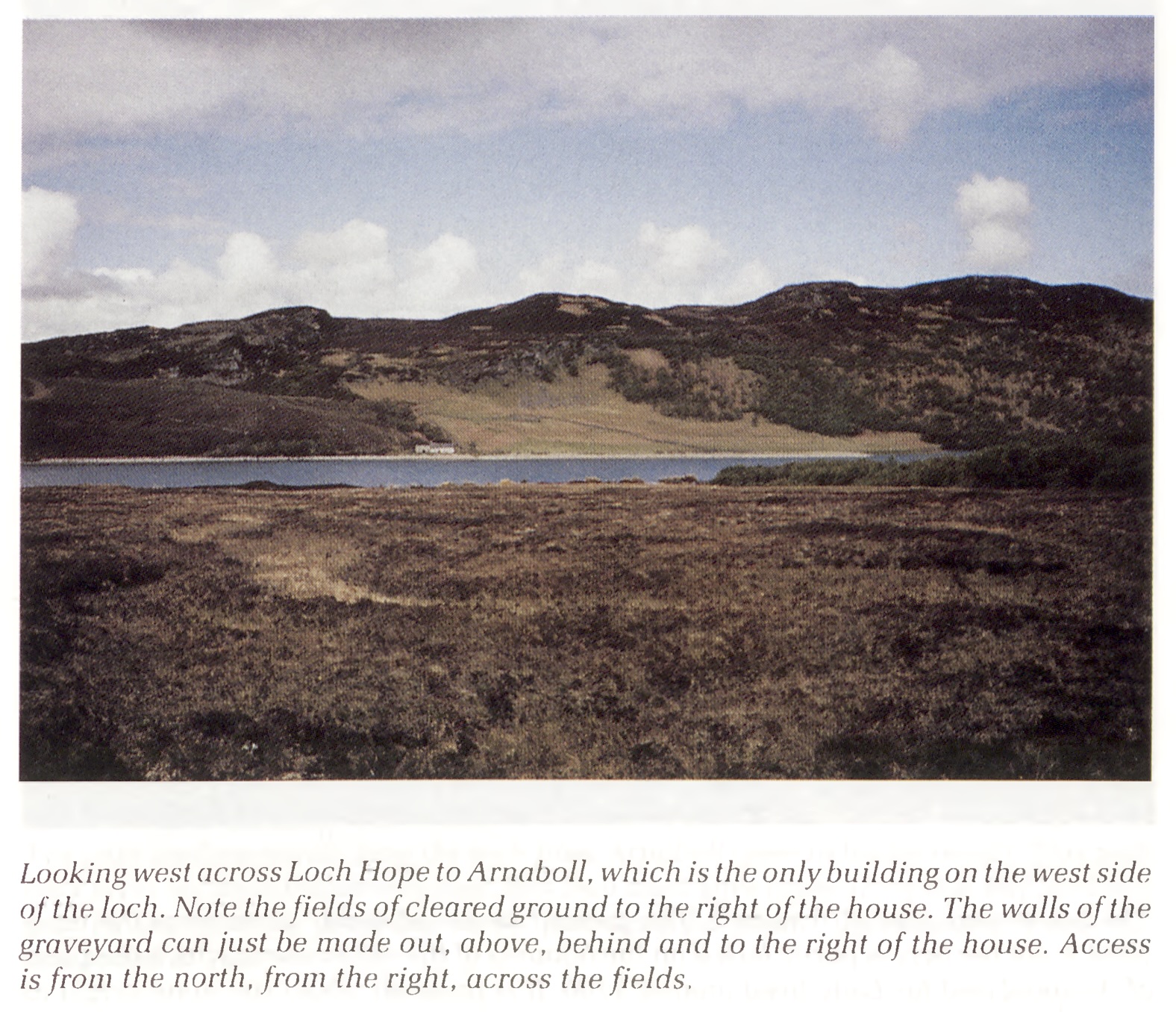 Google Map で旅をすると、この写真の撮られた地点がほぼ特定できます。↑の写真クリックで Google Map 上の(ほぼ)この地点と思われる場所にリンクしています。その地点のストリートビューを見ると、ほぼこの写真通りの風景が展開します。 |
|
| There is no problem in
reconciling the two names, Anapool and Arnaboll.
It is a Norse name, found in a Gaelic-speaking
area where the Norse ending -bol "farm" could
have many forms. Arna-bol "Arni's farm" could
become Arnabol, Arnaboll, Arnapol, Arnapoll, or
could appear with anglicised spellings such as
Arnable, Arnaple or Arnapool. All of these final
endings are found in names in the north, the
most frequent being -pool (as in Ullapool
"Ulli's farm," Unapool "Unni's farm"). The loss of the r in Anapool is almost certainly a copying error. The handwritten symbols for the letters i, n, m and r are often confused in manuscripts, as they are made up of different combinations of the minim ✓ : one minim for i ✓ , two for n ✓✓, three for m ✓✓✓ ,and a familiar sign ✓ for r. In the Rent Rolls and elsewhere Arnaboll is variously spelled Arnnaboll and Arrnnaboll, as well as Arnaboll. Small wonder if the original r was lost somewhere when people in the south no longer knew where the place was, and could not check the spelling. |
Anapool と Arnaboll
という 2
つの名前を調和させることに問題は無い。これはノルウェー語の名前として、ゲール語圏で見られるもので、ノルウェー語の語尾
-bol (農場) にはさまざまな形がある。Arna-bol (Arni の農場)
は、Arnabol、Arnaboll、Arnapol、Arnapoll になる可能性があり、
Arnable、Arnaple、Arnapool
などの英語化された綴りで表記されることもあり得る。これらの語尾はすべて北部の名前に見られ、最も頻繁に見られるのは
-pool (例えば、Ullapool 「Ulli の農場」、Unapool 「Unni
の農場」) である。 Anapool の r が抜けているのは、ほぼ間違いなく書き写す際の誤りである。手書きの i、n、m、r の記号は、最小単位 ✓ のさまざまな組み合わせで構成されているため、写本ではよく混同される。最小単位1つは i ✓: 2つは n ✓✓、 3つは m ✓✓✓、そしておなじみの記号 ✓ は r である。賃貸台帳やその他の場所では、Arnaboll は Arnnaboll、Arrnnaboll、Arnaboll とさまざまな綴りになっている。南部の人々がもはやその場所がどこにあるか分からなくなり、綴りを確認 できなくなったときに、元の r がどこかで失われたとしても不思議ではない。 |
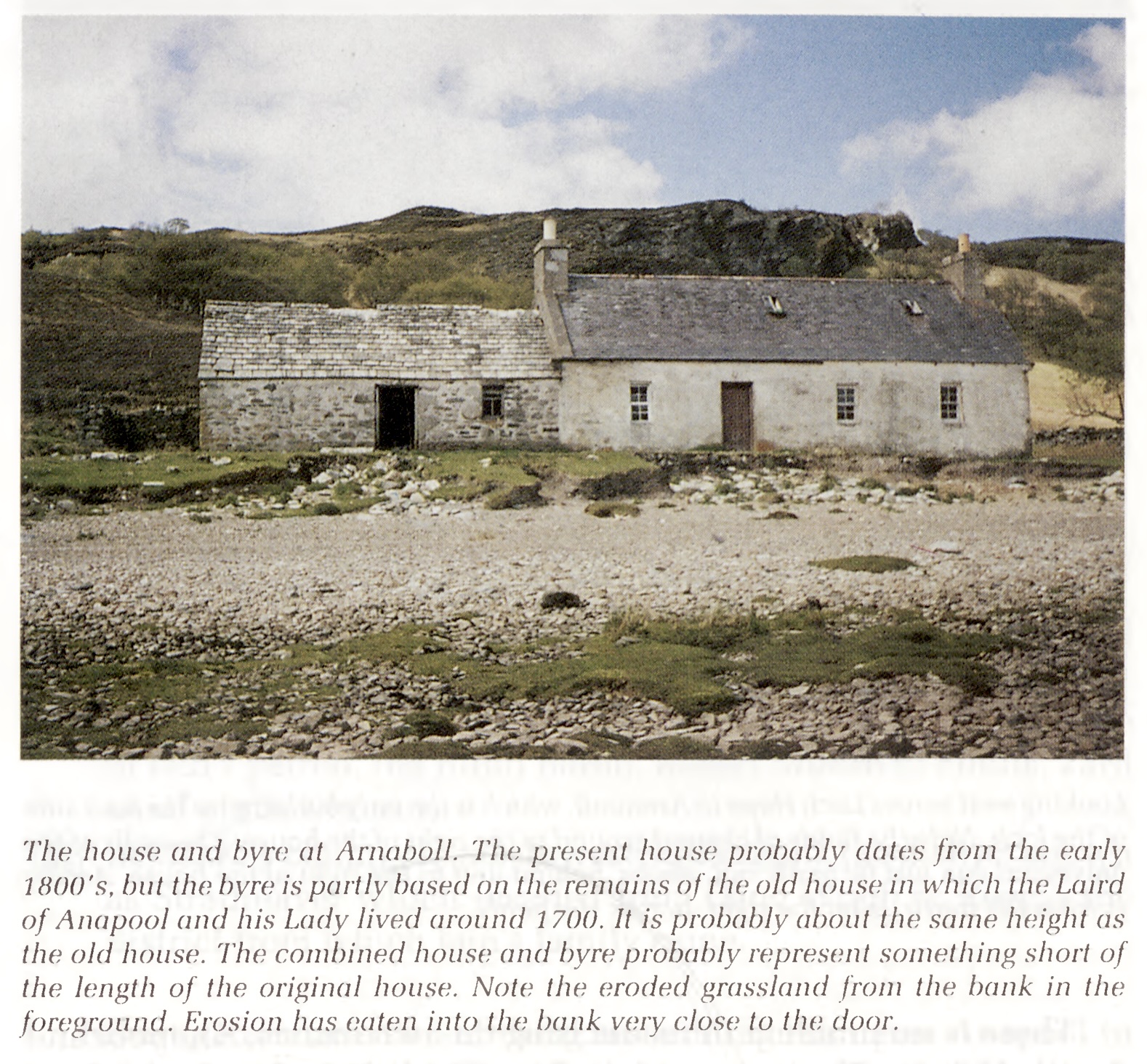 |
|
| So, from its form, Anapool
could be identified with Arnaboll. Why identify
it with Iain Dall's work? Arnaboll is a farm
with a small house on the western side of Loch
Hope, on the Eriboll estate in north-west
Sutherland, east of Durness. The building is
small, but the farm extensive, and it has its
own burial ground, high on the hill behind the
house. This suggests that Arnaboll was once a
place of some importance. There is no graveyard
at Eriboll itself, and the Eriboll people were
taken to Arnaboll for burial. The present Arnaboll house probably dates from the early 1800's, or possibly the late 1700's. It is not the house which would have been there in Iain Dall’s time, but it is built on the foundations of the older house which can be seen clearly at the foot and gable end of the present walls. |
したがって、その形状から、Anapool は Arnaboll と
同一視できる。この場所が何故 Iain Dall
の 作品と特定されるのか? Arnaboll は、Loch
Hope の西側、Sutherland 北西部、Durness の東にある Eriboll
領地にある小さな建物のある農場である。建物は小さいが、農場は広大で、建物の後ろの丘の高いところに専用の墓地がある。これは、Arnaboll が
かつては重要な場所であったことを示している。Eriboll 自体には墓地はなく、Eriboll
の人々は埋葬の際には Arnaboll に行く必要があった。 現在の Arnaboll の建物は、おそらく1800年代初頭、あるいは 1700年代後半に建てられたものだと思われる。Iain Dall の時代にそこにあった建物ではないが、現在の壁の足元と切妻の端にはっ きりと見えている、古い建物の基礎の上に建てられている。 |
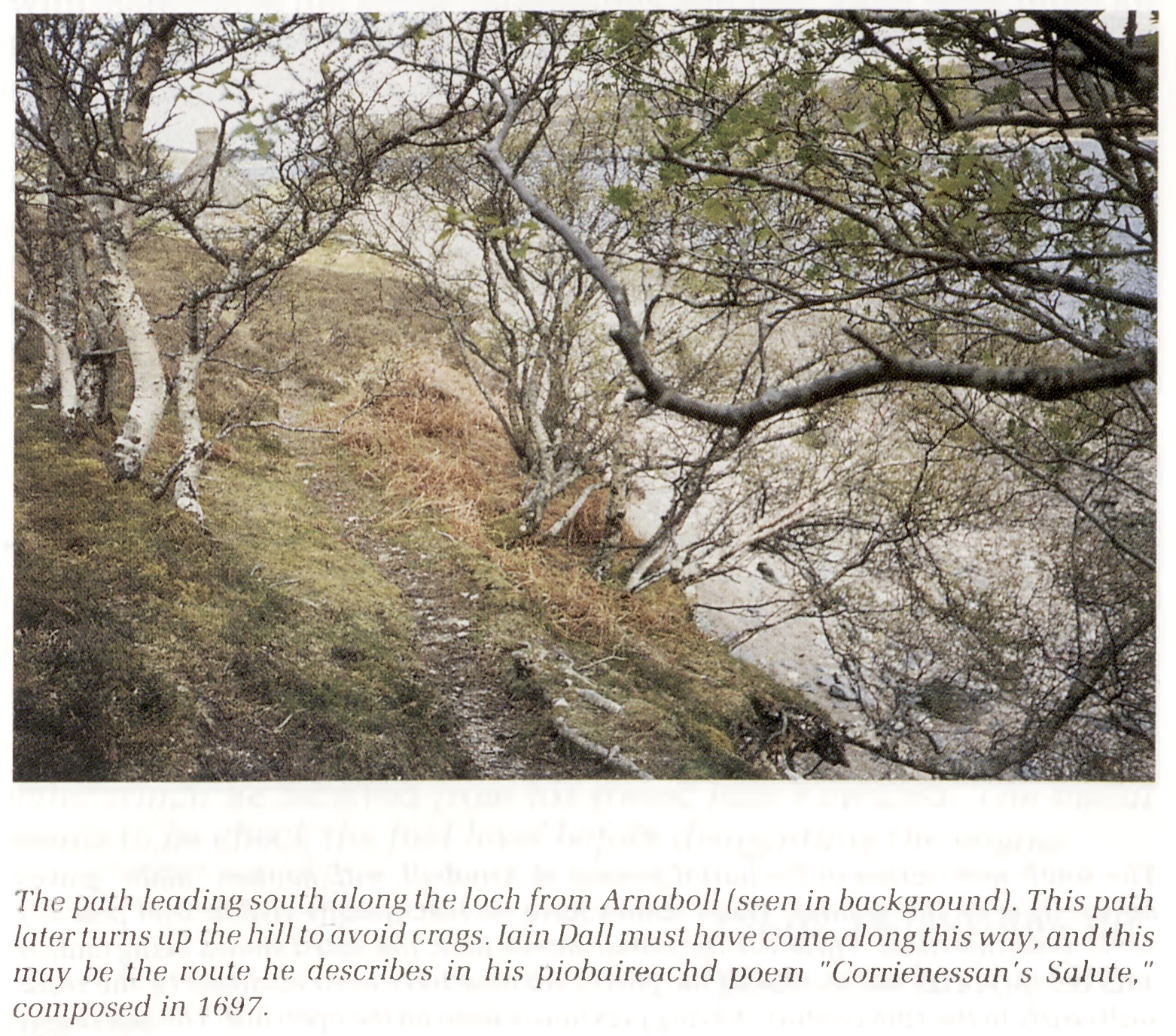 |
|
| Ian Grimble, in his book "The
World of Rob Donn" (pp. 9-10), gave a
description of the house of Iain MacEchain at
Muiseal, a few miles to the south of Arnaboll,
and there is no doubt at all that the house at
Arnaboll would have been the same. Iain's house,
Dr Grimble says, was "...about a hundred feet long, with walls built [in stone] to a height of about three feet above their foundations, the wooden joists that supported the roof embedded in them. The upper part of the walls which might rise to a height of ten feet, was made of turf and the roof was thatched with heather. At the upper end of the house was a room called the "chamber", with chimney and glazed window and a tent-bed in the partition that divided it from the next room. Here the family sat and also took their meals, while the bed was set aside for the use of guests. |
Ian
Grimble は著書 "The World of Rob
Donn"(9-10 ページ) で、Arnaboll の数マイル南にある
Muiseal にある Iain MacEchain
の家屋について説 明している。そして、Arnaboll
の家屋もこれと同じようなものだったことは間違いないだろう。Dr Grimble によると、Iain の家は 「…長さ約100フィート、壁 は [石造りで] 基礎から約3フィートの高さまで建てられ、屋根を支える木製の梁が壁の中に埋め込まれていた。高さ10フィートにも達する壁の上部は芝で作られ、屋根は ヒースで葺かれていた。家屋の上端には煙突とガラス窓が付いた『チャンバー』と呼ばれる部屋があり、隣 の 部屋と仕切る仕切りにはテントベッドがあった。ここで家族が座り、食事もとったが、ベッドはゲスト用に 取っておかれた。」 |
 |
|
| "The chamber opened into a
second room in which the children slept, and
this led to the bedroom of the parents. Beyond
it lay the servants' hall, a room longer than
the others that was called the "Cearn" in
Gaelic. It possessed cross-lights in the form of
small boarded windows on either side, and the
fireplace often consisted of an old millstone in
the centre of the room. The smoke from the
peatfire that burned on it ascended to a hole in
the roof through a funnel of wicker-work open at
both ends, suspended from the ceiling. Only a
slender partition divided the servants from the
byre, which occupied almost half the total
length of the house." These longhouses of the well-born families of the north are very close to the building traditions brought over by the Norse settlers some eight hundred years earlier. These buildings of the 17th and 18th centuries fell into decay readily, the bulk of the structure being made of perishable material. When in the early 19th century estates began to put up stone houses with slate roofs, the stone foundations and low walls were often all that was left of the older buildings, and the new were built on top of the old, making use of existing solid foundations. The remains of the old may often be seen, incorporated into the new. John MacKay's house at Ayre, Raasay, is one example, Arnaboll is another. It is evident that at Arnaboll the older house was both narrower and longer than the present. It was a house typical of those occupied by the "gentry," the descendants of the Lords Reay, and local MacKay leaders. |
「このチャンバーという部屋は、子供たちが眠る2つ目の部屋に通じて
いて、そこから両親の寝室に通じていた。その向こうには、他の部屋よりも長い使用人用の広間があり、
ゲール語で "Cearn"
と呼ばれていた。両側に小さな板張りの窓の形をした十字型の明かり取りがあり、暖炉は部屋の中央にある古い石臼でできていることが多かった。その上で燃え
るピート(泥炭)の煙は、天井から吊るされた両端が開いた枝編み細工の漏斗を通って、屋根の穴に上がっ
ていった。 使用人と牛小屋は、家の全長のほぼ半分を占める細い仕切りで隔てられていた。」 このような北部の裕福な家庭の長い建物は、約800年前にノルウェー人入植者が持ち込んだ建築の伝統 に極めて近い様式である。 17世紀から18世紀に掛けて建てられていたこれらの建物は、構造の大部分が腐りやすい材料で作られ ていたため、すぐに朽ちてしまった。19世紀初頭に領地でスレート屋根の石造りの家を建て始めたとき、 古い建物から残ったのは石造りの土台と低い壁だけであることが多く、新しい家は既存の堅固な土台を利用 して、古い家の上に建てられた。古い家の残骸が新しい家に組み込まれているのをよく見ることができる。 Raasay 島の Ayre にある John MacKay の家(※)がその一例で、Arnaboll の家屋も別の例である。Arnaboll の古い建物は現在の建物よりも狭く、長かったことは明らかである。それは「大地主」たる、Lords Reay の子孫、地元の MacKay の指導者が住むに値する典型的な家屋だった。 ※ 参考記事:"Piping Today" No.49〜No.51 |
| Part2 【Vol.47/No.10-1995/7-P16】 |
|
| The link between these people
and Iain Dall is complicated, and we must go
back to 1632, when Donald Duaghal MacKay, the
14th Chief of MacKay, was being harried by the
Earl of Sutherland. Donald was extremely short
of money, and the Earl wanted to buy land from
him. Donald did not trust him, and did not want
the Sutherlands to gain a hold on his lands; but
he knew he had to sell something. So he made a
deal with someone he knew he could trust, Hector
Munro of Linside, who was married to a cousin of
Donald's, Janet MacKay of Achness. She was
descended from the Munros of Foulis, a family
who were very friendly with Donald. This bond
between the Munros and the MacKays had lasted
for several centuries, and was particularly
strong in Donald's time, the first half of the
17th century. Hector Munro was sold the estate of Eriboll, land not on the fringes of MacKay country but in its heart, on the north coast, surrounded on three sides by MacKay lands. Hector became the first Laird of Eriboll. (See the Line of Descent). His son, Hector Munro II of Eriboll, who died in 1660, had several sons, of whom the third was Donald Munro. To Donald he gave the tack (long lease) of Arnaboll, so that Donald became the first Laird of Arnaboll ー but not the one for whom the Lament was made. Donald had no sons, and his eldest, possibly his only daughter was his heir Marion Munro, of Arnaboll. She married her first- cousin, Donald MacKay, second son of John MacKay of Skerray. Donald MacKay was related to the MacKays at Muiseal, who included Isabel MacKay in the mid-18th century. It is Donald MacKay of Arnaboll who was the Laird of Anapool commemorated in the Lament, and Marion Munro, his wife, was the Lady of Anapool. Their descendants were the Mackays of Arnaboll for many generations. Donald himself is rather a shadowy figure: the only certain thing we know about him is that he was a lawyer who graduated from Edinburgh University and qualified as a Writer to the Signet (= a barrister) in 1686 - when Iain Dall had just completed his training in Skye and returned to Gairloch. It seems likely that Donald and Iain were much the same age. What is the link that makes us certain that Donald was the Laird of Anapool? He and Iain Dall were second-cousins, both being descended from Donald Duaghal MacKay, 1st Lord Reay. Iain was a grandson, through an illegitimate daughter of Lord Reay; Donald was Lord Reay's great-nephew. |
これらの人々と Iain
Dall とのつながりは複雑なので、時代を1632年まで遡らなければならな
い。当時、MacKay 家の第14代チーフ
Donald Duaghal MacKay は Sutherland 伯爵に執拗に攻撃され
ていた。Donald は極度の金欠
で、伯爵は彼の土地 を買い取ってしまいたいと考えていた。Donald は
彼を信用しておらず、Sutherland
家に土地を渡したくは無かったが、何かを売らなければならないことはわかっていた。そこで彼は、彼と非常に親しかった一族、Munros
of Foulis 家の子孫で、彼の従姉妹にあたる、Janet
MacKay of Achness と結婚していて、彼が信頼できる人物、Hector Munro of Linside
と取引をした。Munro 家と MacKay 家の絆は数世紀にわたって続き、Donald の時代、17世紀前半には特に強
固だった。 Hector Munro は Eriboll の地所を売却した。その地所は MacKay の土地の縁ではなく、その中心、北の海岸沿いにあり、3方向を MacKay の土地に囲まれていた。Hector は Eriboll の初代領主となった。(系図を参照) 彼の息子、Hector Munro II of Eriboll は 1660年に死去したが、彼には数人の息子がいた。その3番目が Donald Munro だった。彼(Hector Munro)は Donald(Munro) に Arnaboll の土地 (長期リース) を与えたため、Donald(Munro)は Arnaboll の初代領主となった ― しかし、このラメントの対象となったのは彼ではない。 Donald には息子がおらず、長 女で恐らく唯一の娘は、彼の後継である Marion Munro of Arnaboll だった。彼女は従兄弟の Donald MacKay と結婚。Donald MacKay は、John MacKay of Skerray の 次男である。Donald MacKay は、 18世紀半ばの Isabel MacKay を 含む、MacKays at Muiseal 家と親戚関係にあった。ラメントで追悼されている Laird of Anapool は Donald MacKay of Arnaboll であり、妻の Marion Munro が Lady of Anapool である。 彼らの子孫は、何世代にもわたって MacKay of Arnaboll 一族 だった。Donald 自身は、むしろ謎めいた人物である。彼について私たちが知っている唯一の確かなことは、彼がエディンバラ大学を卒業し、1686 年に Writer to the Signet (法廷弁護士) の資格を取得した弁護士だったということである。その頃、Iain Dall は Skye 島でのパイプ研修を終えて Gairloch に戻ったばかりだった。Donald と Iain は、ほぼ同じ年齢だったと思 われる。 Donald が Laird of Anapool だったと確信させる繋がりは何だろうか? 彼と Iain Dall は従兄弟同士で、どちらも 初代 Lord Reay、Donald Duaghal MacKay の子孫である。Iain は Lord Reay の非嫡出娘の孫で、Donald は Lord Reay の甥の孫である。 |
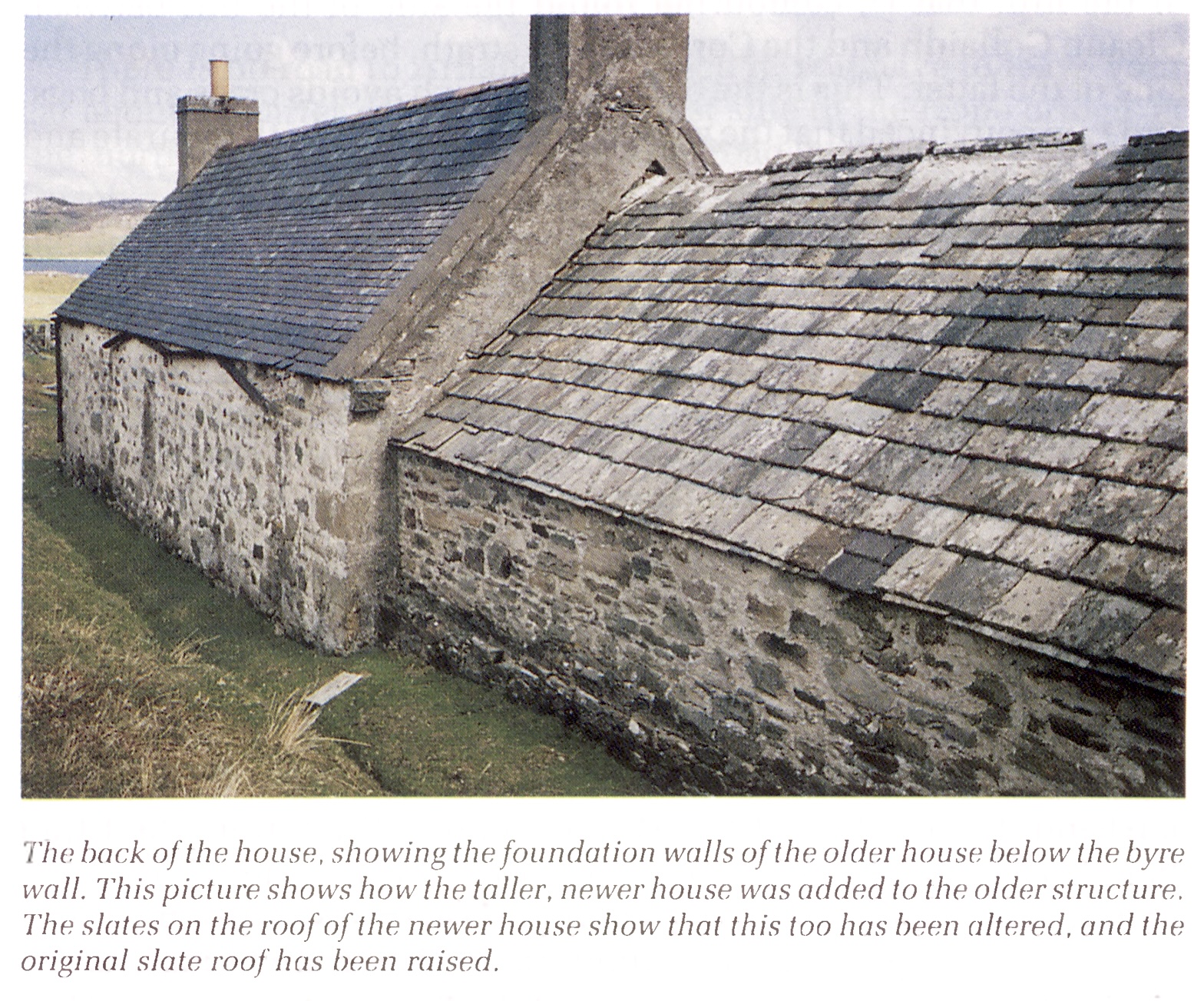 |
|
| There is no concrete evidence
that Iain Dall was ever at Arnaboll, but the
unusual wording of some passages in his poem
"Corrienessan's Lament" strongly suggests that
he was familiar with the place. In the opening verses of the poem, he says that he was leaving the north after the death of his patron, Colonel Robert MacKay. He says he was travelling by "the upper reaches of the Alltan Riabhach," and this has been taken to refer to a burn of that name to the south of Ben Hope indicating that he was coming from Tongue, making his way west. (See Haddow, p. 138). But Iain Dall specifically mentions the "upper reaches" of the burn, and there is another burn of that name which flows into the southern end of Loch Hope, a few miles south of Arnaboll. Anyone travelling from Arnaboll to the Corrienessan strath has to cross the Alltan Riabhach, and if he keeps too low, along the lochside, he will find his way blocked by crags. To reach the pass, the way through the hill to Gleann Gollaidh and the Corrienessan strath, it is necessary to keep high on the hillside and cross the UPPER reaches of the bum. This convinces me that Iain Dall was travelling from Arnaboll, not Tongue, on the journey he describes in the poem. It makes a shorter day: from Tongue to Loch Stack in one day is a vast distance for a blind man, but from Arnaboll it is more reasonable. He goes on to say he came by a route "leth-taobh" - "halfway up the side" of the hill, that is, contouring round the side of the hill between Gleann Gollaidh and the Corrienessan strath, before going along the side of the latter. This is the only route which avoids crags and bogs, and I am convinced that the wording of the poem is both accurate and carefully chosen. The path from Arnaboll, at the time of year that Iain Dall describes, which must have been late May or early June, when the country was full of flowers, is delightful even now. The footpath skirts Loch Hope through pretty birchwoods, and the scenery across the loch and to the south is magnificent. |
Iain Dall
が Arnaboll に居たという確たる証拠は無いが、彼の詩 "Corrienessan's
Lament"
のいくつかの節の際立った言い回しは、彼がその場所をよく知っていたことを強く示唆している。 詩の冒頭の節で、彼は、パトロンの Robert MacKay 大佐の死後、北の方向に出発しようとしている、と謳っている。彼は "Alltan Riabhach 川の上流域" を旅している、と謳っているが、これは Ben Hope 山の南にある同名の小川を指していると解釈されており、彼が Tongue から西へ向かっていたことを示している。(Haddow,138 ページを参照) しかし、Iain Dall は特に小川の《上流》について言及しており、実際には、Arnaboll の数マイル 南の Loch Hope の南端に流れ込む同名の小川がもう1つ存在する。Arnaboll から Corrienessan 峡谷へ旅する者は、Alltan Riabhach 川を渡らなければならないが、湖岸に沿って余り低く歩き続けると、岩山で道がふさがれることになる。峠、つまり丘を抜けて Gleann Gollaidh と Corrienessan 峡谷 に至る道に到達するには、丘の斜面を高く登り、bum の《上流》を横切る必要がある。 このことから、詩の中で描写している旅では、Iain Dall はTongue からではなく、Arnaboll から旅していた、という事が確信できる。その方が1日の所要時間が短くな る。Tongue から Loch Stack までの距離を1日で行くのは、盲人にとっては甚だ負担となる距離であるのに比べて、Arnaboll から行く方がより合理的である。彼は続けて、丘の "leth-taobh"(斜面の半分)、つまり Gleann Gollaidh と Corrienessan 峡谷の間の丘の斜面を回り、その後、後者の斜面に沿って行くルートを通って来た、と述べている。これは岩山や沼地を避ける唯一のルートであり、詩の文言は 正確で、そのルートは慎重に選ばれたものであると私は確信している。 Iain Dall が詩の中で描写 している時期は5月下旬か6月上旬だったはず。つまり国中が花で満ちているこの時期の Arnaboll からの小道は、現在でも美しい。遊歩道は美しい白樺林を抜けてLoch Hope の周囲を巡り、湖の向こう側と南側の風景は壮大である。 |
| The Lady of Arnaboll was Marion Munro, Donald MacKay's wife. She was the real tenant of Arnaboll, by right of inheritance from her father; and Iain Dall's second-cousin Donald MacKay was the Laird only by virtue of his marriage to her. I think this is one reason why there are two Laments. Another reason why Marion merited a lament of her own was that she was a Munro, distantly related, as was her husband, to the Chief of the Munros, Iain Dall's patron, the Blind Baron of Foulis. The tunes seem both to have been made to please this patron, and they were among a group of seven piobaireachd works which Iain composed for the Blind Baron. The Lament for Marion, the Lady of Arnaboll, is more formal and less personal in feeling than that for the Laird, which is full of a tearing grief and deep feeling, suggesting that Iain had lost a dear friend. | Lady of Arnaboll とは、Donald MacKay の妻、Marion Munro である。彼女は父からの相続権により Arnaboll の実質的な借地人であり、Iain Dall の従兄弟 Donald MacKay は彼女と結婚した ことにより領主となった。これがラメントが2つ存在する理由の1つだと考えられる。Marion がラメントに値するもう1つの理 由は、彼女が Munro であり、彼女の夫と同じく、Munro 家のチーフで Iain Dall のパトロンである Blind Baron of Foulis と遠縁だったことである。これらの曲は両方ともこのパトロンを喜ばせるために作られたと推測され、Iain が Blind Baron のために作曲した7つのピーブロックの作品群の中に入っている。Lament for Marion, the Lady of Arnaboll は、領主自身へのラメントよりも形式的で感情があまり個人的ではない。一方で、領主自身へのラメントは、引き裂かれるような悲しみと深い感情に満ちてお り、Iain が親しい友人を失ったこ とを示唆して いる。 |
| Beside the house at Arnaboll are
flat green fields along the loch, with very old
drystane walls. These walls are constructed in
an unusual pattern with square holes, usually an
indication that the owner was quite well off.
This part of the farm is a small pocket of
fertile land, with a great deal of rough grazing
on the hill. It is used nowadays for sheep. A
burn runs down the hill to pass the north gable
of the house, and Loch Hope laps the bank in
front of it ー too close in front, as the bank is
eroding badly and the house is in danger of
being undermined. Mr Clark, the proprietor of
Eriboll estate, assures me that if the situation
deteriorates the estate will take action to halt
the erosion and save the house. He is most
interested in the history of Arnaboll. The views from Arnaboll are wonderful, and the place is an archaeologist's paradise, with a chambered cairn in the home field, two more beside the access path as you approach from the north, and a prehistoric dun and several unidentified ruins as well, all close to the path. There is no road to Arnaboll. To reach it, you have to leave your car about a quarter of a mile on the west side of the Hope bridge, at the north end of Loch Hope, on the road between Tongue and Durness. There is a lay-by for parking beside a high ladder-stile over the deer-fence, and you follow the newly bulldozed estate track on foot. This now goes as far as the home field, but previously there was a narrow footpath through the trees, beautiful with flowers in May and June but obliterated by bracken from July onwards. It is a walk of about two miles to Arnaboll, with the loch on your left, and the woods in May are full of bluebells, violets, primroses and St John's wort, all the flowers and buds described by Iain Dall in "Corrienessan's Salute". The house is now uninhabited, used only by the estate shepherds and foresters. High on the hill behind it is the burial ground, surrounded by substantial stone walls. In it are the graves, mainly from the 19th century, of Eriboll and Arnaboll folk, mostly estate workers. There are a few very old slabs with no inscriptions, the remains of old Highland grave-markers known as "table" graves. They look like stone camp-beds, with a long narrow flat slab, often of sandstone, raised a few inches horizontally above the ground on six little stone legs. Through time, the legs sink into the ground and the slab comes to rest on the earth. Many of these "table" graves seem to date from the 17th and 18th centuries, so far as they can be dated at all. They rarely have inscriptions, or the inscriptions have been obliterated by time and weather. Two such slabs lie side by side on the ground in the south-west (upper) comer of the Arnaboll graveyard, on the right as you go in through the gate. It is tempting to make a guess that the two slabs mark the resting-place of the Laird and his Lady, but there is no proof whatsoever. On the other hand, no other graves have been found which could be said to be theirs ... Iain Dall's poem "Corrienessan's Lament" describes a big deer hunt on the hill, with the gralloching of the prey carried out in the corrie itself, while the harpers played and sang to entertain the company. Afterwards the hunt made its way down from the hill, and one of the final verses has a scene of relaxation and merriment in a house nearby - could it have been Arnaboll itself? Iain tells how they left the hill for lower ground "full of confidence and conversation." In the house they had "waxen candles and wine, drinking horns, flagons, stringed instruments playing, and no shortage of drink and music, everything well-ordered and civilized." He expresses all this in twelve pithy adjectives, with no nouns or verbs, so that translation is not easy. If this was not Arnaboll itself, it must represent what a good night at Arnaboll was like in his time, hosted by the Laird and his Lady. Iain's words were these: |
Arnaboll の建物の横には、湖沿いに平らな
緑の野原が広がり、非常に古い乾石壁がある。これらの壁は、四角い穴が開いた珍しいパターンで造られて
おり、通常、所有者がかなり裕福であったことを示している。農場のこの部分は小さな肥沃な土地で、丘の
上には広大な荒れた牧草地が広がっている。この場所は現在、羊の飼育に使用されている。丘を下って小川
が流れ、家の北側の破風を通り、Loch
Hope の水面が家の前の土手に打ち寄せている。目の前に近
すぎるので、土手の浸食がひどく、家が崩壊する危険がある。Eriboll の地所の所有者である Clark
氏は、状況が悪化した場合は、地所の責任で、浸食を止めて家を救う措置を講じると言って、私を安心させた。彼は
Arnaboll の歴史に非常に強い興味を持っている。 Arnaboll からの眺めは素晴らしく、この場所は考古学者の楽園である。敷地内には石室のあるケルンが1つあり、北からアクセスする小道の横にさらに2つのケルンがあ り、先史時代の dun と、いくつかの未確認の遺跡もすべて小道の近くにある。 Arnaboll へ通じる車道は無い。そこに行くには、Hope 橋の西側、Loch Hope の北端、Tongue と Durness の間の道の約4分の1マイル先に車を停めなければならない。鹿よけの柵を越える高い梯子の柵の横の駐車用の路肩に車を停め、新しく整地された敷地の小道を 歩いて進む。この道は今では家屋の畑まで続いているが、以前は木々の間を通る狭い小道があり、5月と6 月は花が咲き誇っているが、7 月以降はシダ類に覆われてしまう。Arnaboll ま では、湖を左手に見ながら歩いて2マイルほどの距離。5 月の森はツリガネソウ、スミレ、サクラソウ、セイヨウオトギりソウで一杯である。これらはすべて、Iain Dall が詩作 "Corrienessan's Salute" の中で描写している花や蕾である。 この建物には今や誰も住んでおらず、農園の羊飼いと森林管理人だけが使用している。その背後の丘の上 には、堅固な石壁に囲まれた墓地がある。そこには、主に19世紀の Eriboll と Arnaboll の民衆の墓があり、そのほとんどは農園労働者である。 碑文のない非常に古い石板がいくつかあり、これは「テーブル墓」として知られる、古いハイランドの墓 標の遺物である。それらは、石のキャンプベッドのように見え、細長い平らな石板 (多くの場合は砂岩) が6本の小さな石の脚で地面から数インチ水平に持ち上げられている。時が経つにつれて、脚は地面に沈 み、石板は地面に落ち着く。これらの「テーブル墓」の多くは、年代がわかる限りでは 17世紀と 18世紀のようである。碑文が刻まれていることはまれで、また、刻まれていたとしても長い年月と天候によって消えてしまっている。このような石板2枚が、 Arnaboll 墓地の南西 (上部) の角、門を入って右側の地面に並んで横たわっている。この 2枚の石板は領主と夫人の墓所を示すものであると推測したくなるが、それには何の証拠も無い。一方、彼 らの墓と言えるような墓は他には発見されていない...。 Iain Dall の詩作 "Corrienessan's Lament" は、丘での大規模な鹿狩りを描写している。窪みの中で獲物を捕らえる間、ハープ奏者たちは演奏し歌い、観客を楽しませた。その後、狩りは丘から下り、最後 の詩節の1つには近くの家でのくつろいだ楽しい場面がある。それは Arnaboll そのものだったのだろうか? Iain は、 彼らが「自信と会話に満ちて」丘を下りて低地へ向かった様子を語っている。家の中では「ろうそくとワイ ン、角酒器、大瓶、弦楽器の演奏、飲み物と音楽の不足はなく、すべてが整然として文化的だった」。 彼はこれらすべてを、名詞や動詞を使わずに12個の簡潔な形容詞で表現しているため、翻訳は容易では ない。これが Arnaboll そのものではないとしても、彼の時代に領主とその妻が主催した Arnaboll での楽しい夜がどのようなものであったか、を表している事には違いない。Iain の詩文は次のとおりである : |
| "Gu
cinnteach, ciannteach, cainleach, ceireach, fionach, cornach, stopach, teudach, ordail, ol-mhor, ceol-mhor, ceutach" |
|
| He probably sang them to the
accompaniment of the harp. They are part of the
pattern he created when he made the poem on the
model of a piobaireachd, and this verse may be
part of a Dithis variation. But that's another
story ... |
おそらく彼はハープ伴奏に合わせて歌ったのであろう。これらは彼が
ピーブロックをモデルに詩を作ったときに作ったパターンの一部であり、この詩節は Dithis
バリエーションの一部かもしれない。しかし、それはまた別の話である... |
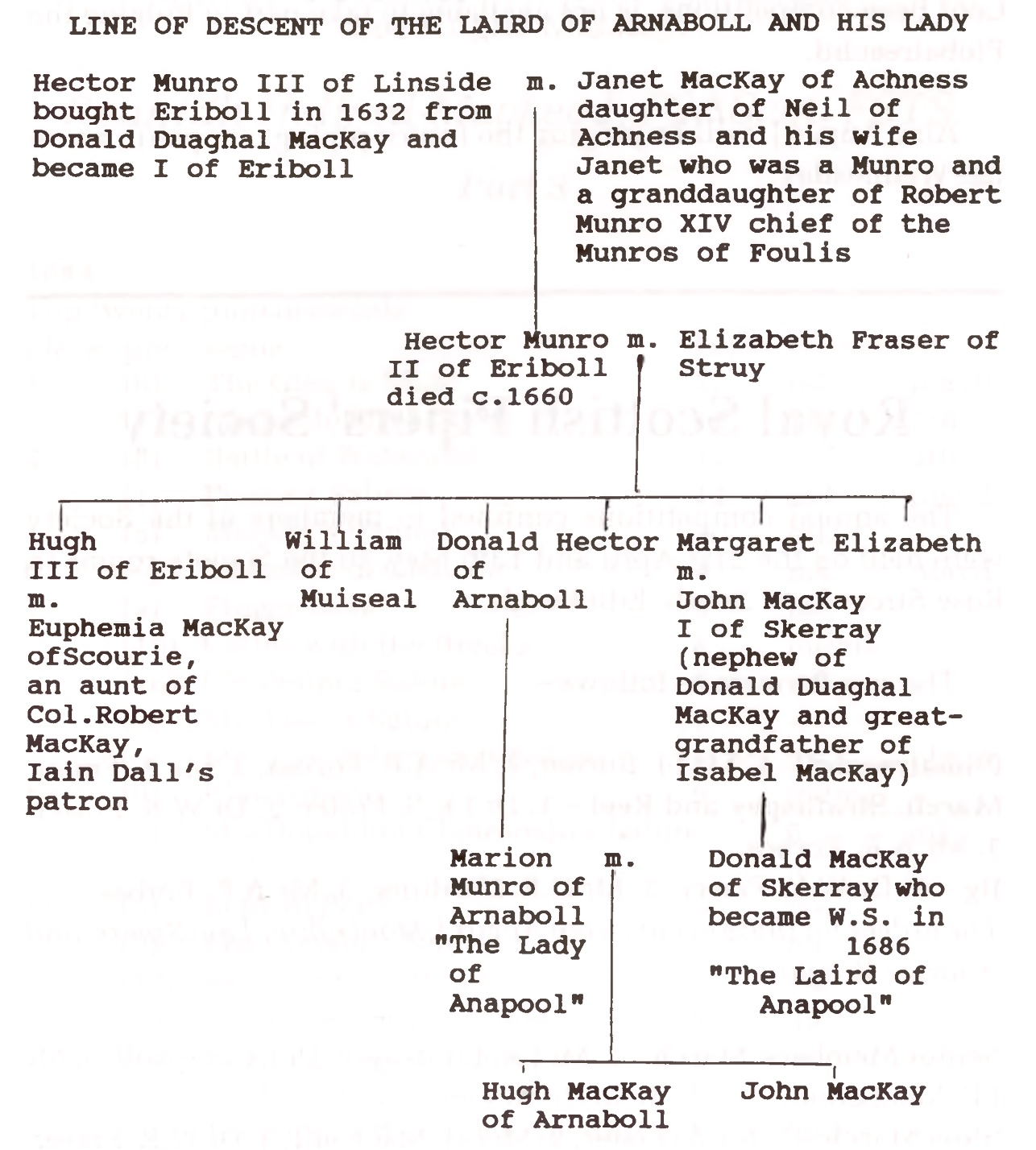 |
|
| References: The Book of MacKay, Angus MacKay, Edinburgh, 1906 The History of the Munros, Alexander MacKenzie, 1898. Pre-1855 Tombstone Inscriptions in Sutherland Burial Grounds, ed. A.S. Cowper and I. Ross (Scottish Genealogical Society) 1991. The History and Structure of Ceol Mor, A.J. Haddow, published privately, 1980. Piobaireachd Society's publication of Piobaireachd, Book 9. Angus MacKay Manuscript (unpublished). The World of Rob Donn, Ian Grimble, Edina Press, 1979. The Chief of MacKay, Ian Grimble, 1965, re-issued by the Saltire Society, 1993. |
|
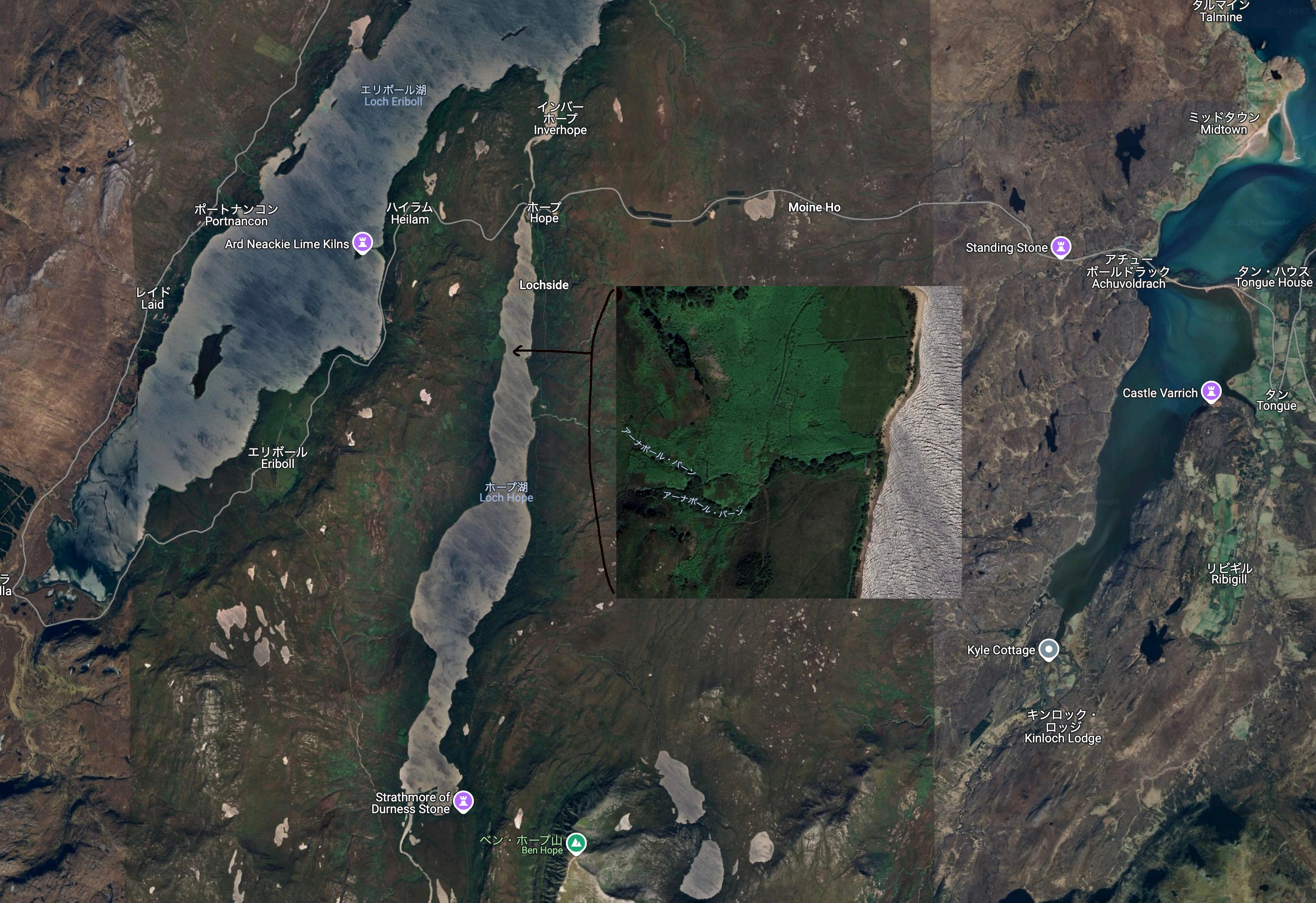 ↑↓from GoogleMap (クリックで拡大)  |
|